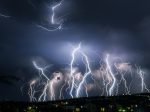Gently floating down the Flathead River in Montana’s Glacier National Park offers a stunning 360-degree view of the mountains, pine trees and blue mountain sky. After cruising past what the park rangers call the “Bone Crusher” pass, smooth waters carry tourists toward an open swimming area where the river deepens. Dark and eerie memories trapped under the surface entrance those who lean over the edge of their rafts and gaze into the depths of the water. From the darkness, monstrous machinery peeks into view. This is the resting place of sunken train cars, ushered there by the 1964 Montana Flood.
The Storm Before the Storm
On June 7, 1964, the state of Montana experienced an intense rainstorm, which was the result of humidity from the Gulf of Mexico clashing with the frigid air from the north. The previous winter was a wet one, leaving snow-packed mountains. The collision of elements caused the area to receive one inch of rain every hour.
High water levels are not unusual in Montana. The state prepares for natural disasters like this from mid-May to mid-June every year during flooding season. These particular levels, however, were unprecedented.
The Liquid Destruction
On the morning of June 8, the water became so fierce that the waves charged over the Gibson Dam near Augusta, Montana, at a height of about 200 feet. All the towns and crops within 80 miles of the dam flooded. Approximately 128,700 tons of water rushed into the local communities at a rate of 50,000 feet per second.
On an average day before the flood, the water in this area of the river moved at a rate of about 700 feet of water per second. On June 8, 1964, however, it was reported that 8,300 cubic feet of water moved per second.
The water entered Glacier National Park, which hosted a railroad that had been there since 1913, known as the Great Northern Railway, and ran toward the Middle Fork of the Flathead River. The flood acted as a cruel lumberjack, chopping down pine trees throughout the park and thrusting them toward residential areas. These traveling trees served as an early evacuation warning to some of the families in the area. They were the first of approximately 5,500 people who were eventually evacuated.
The Flood’s Impact
The flood rose high above the tree line. It threw mud into the railway tunnel and destroyed 16 bridges as well as 66 miles of road.
The water didn’t just ruin landscape, however. Thirty-one people drowned, including tourists, Kalispell residents and people who lived on the Blackfoot Reservation. One hundred people were reported missing after the disaster, and 1,200 became homeless after hundreds of homes were wiped out. The vast majority of those displaced were Native American.
“Tragedy was to be found everywhere, but if any single segment of the population was hit and hit hardest, it was the Blackfeet Indians on the Reservation,” said Bob Norris, a radio announcer on KSEN.
In addition to those killed, missing and displaced, 350 people were injured.
After the flood rolled back and it was safe to return to the area, volunteers spent weeks searching both inland and near the water for the people they missed. One hundred people remained missing after the search parties stopped combing through the brush and scouting out the fields and riverbanks.
Nowadays, the government typically taxes U.S. citizens $2 billion a year just for flood relief. The tax comes during years when there are no major floods, though. The 1964 Montana Flood stole so much life, land and property, but during that same year, the government granted a total of just $62 million for recovery, according to the U.S. Geological Survey and Montana Department of Natural Resources and Conservation. In today’s currency, that would equate to $474 million.
In total, it took the Blackfoot tribe two years to restore their reservation to what it was before the disaster. Shortly after the flood, the tribe declared June 8 to be an annual day of remembrance and mourning for those lost to the 1964 Montana Flood. To this day, services are still held every year in a Native American museum to show respect.
Looking Back from 2021
Just as a forceful flood can cause long-lasting damage to a community, other elements can have the same effect.
In 1964, Montana suffered from a famous flood. But in 2021, the enemy to the safety of Montana locals is water’s rival: wildfires. In contrast to the desires of those alive during the 20th-century disaster in Montana, Kalispell and West Glacier occupants are praying for rain.
As of Aug. 10, at least 24 large, active wildfires are ravaging the state, with national attention on the Northern Rockies in western Montana. While locals receive pre-evacuation warnings and pack their belongings in cautious preparation, the danger serves as a reminder of what Montana went through in the past. But it also recalls the strength of the community to rebuild itself after destruction.
The Blackfoot tribe holds annual services to remember their loved ones who were lost in the flood. The train cars nested at the bottom of the Flathead River also serve as their own haunting memorial for anyone willing to stare into the river’s abyssal museum. In this way, the stories of those lost in the 1964 Montana Flood will not be forgotten.
















